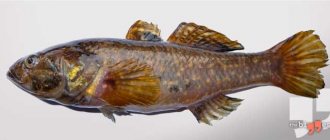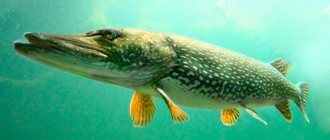Fish are not only our source of food. They are also fascinating and amazing creatures of nature that sometimes you just want to behold. But the most exciting "attribute" of fish is their ability to quickly
swim at incredible speed.
They use their incredible speed to chase food or escape predators. In general, the ability of fish to swim quickly is their way of surviving in the wild, or rather in the waters.
We present to your attention a list of the fastest fish in the world, as well as their maximum swimming speed. Some of the things listed here may surprise you, but the truth is that fish truly are some of nature's greatest wonders.
Southern bluefin tuna
Also one of the favorites in sport fishing. Based on the name, you probably guessed that this type of tuna lives in the southern hemisphere. They grow 2.5 m in length and weigh about 400 kg (bluefin tuna have very large bones, which makes them so heavy).
Maximum speed of bluefin tuna
– 74 kilometers per hour.
Second place: swordfish
Swordfish
The second place on our pedestal is occupied by a predator, swordfish. Thanks to calculations, it was possible to find out that the oceanic animal can reach speeds of up to 100 kilometers per hour . The main advantage of the animal is its elongated upper jaw, thanks to which the fish hunts, using the jaw to stun prey. On average, the weight of the fish is up to 500 kilograms.
Unlike many other fish species, swordfish cannot maintain temperatures above ambient temperatures.
Third place – black marlin
Black marlin
The third place in the ranking is occupied by fish, black marlin. Thanks to research conducted by Air Force scientists, it was discovered that marlin reaches speeds of 85 kilometers per hour . Information is based on fish caught on heavy-duty line. The fish got its nickname for a reason. Marlin is very similar to a pile (a metal rod with a pointed end).
Watching marlin is a pleasure, because the fish swims with its jaw open. Water entering the open mouth supplies the gills, and consequently the entire body, with oxygen. There have been cases where a marlin was caught on a hook, but never succumbed to the fishermen. And all due to powerfully developed muscles.
Black Marlin
Maximum speed : 105 km/h. Scientific name : Istiompax indica
Black marlin is a large fish species found in tropical and subtropical waters of the Pacific and Indian Oceans. With a maximum recorded weight of 750 kg and a length of 4.65 m, black marlin is one of the largest bony fish species in the world. And with the highest record speed of 105 km/h, black marlin is perhaps the fastest fish species in the world.
Fourth place - wahoo
Wahoo fish
The fourth fastest fish is the fish called wahoo. This fish lives in the waters of the Atlantic and Pacific Oceans. The main feature of the wahoo is its impressive length. The maximum length of the fish, recorded in 1998, is as much as 2.5 meters. The speed of the wahoo fish is not much, not less, as much as 78 kilometers per hour . This fish dives to a depth of more than 12 meters. And no, not for relaxation.
It is at a depth of 12-20 meters that squid, tuna and other sea creatures that wahoo loves to feast on spread. Wahoo are very exciting hunters. It quickly picks up speed and literally drives into a school of small fish that feed on plankton near the surface.
Sailfish
It received this name due to its beautiful fin. Outwardly, it really resembles a sailboat. The fish's sharp nose and body shape cause it to reach speeds of up to 100 km/h. This helps her a lot in hunting for small fish.
Studying the list of the fastest fish in the world, it can be noted that it includes representatives of the seas and oceans. Freshwater inhabitants are not capable of reaching such speeds.
sailboat
Many sources indicate that the sailfish is the fastest fish in the ocean. The ReefQuest Shark Research Center studied the speed of the sailfish and determined that it was 109 km/h during the jump.
The sailfish can grow up to 3.5 meters in length and weigh about 100 kg. Their most noticeable characteristics are the large first dorsal fin (sail-like) and the upper jaw, which is long and sharp. The swallowtail has a blue-gray back and a white underside.
Sailfish live in temperate and tropical waters of the Atlantic and Pacific oceans. They feed mainly on small bony fish and cephalopods.
Distribution and habitats
This fish is an inhabitant of the ocean depths. For habitat it prefers water temperatures above 23 degrees Celsius. As a rule, marlins are found in open waters, but rarely enter continental shallow waters and shelf areas. The fish does not form numerous aggregations, however, it does not lead a solitary lifestyle. Marlins usually gather in small groups. Which include up to 10 individuals.
This fish is found in the tropical and subtropical regions of the Pacific, Indian and Atlantic Oceans. Most individuals prefer to live along the equator line. Very often it can be found almost at the surface of the water, at a depth of up to 50 meters. However, some sources contain information that it can easily dive to a depth of more than 1800 meters.
Southern Bluefin Tuna | Speed up to 74 km/h
Southern bluefin tuna , with a swimming speed of 74 km/h, ranks fifth in the ranking of the fastest fish in the world. Pacific bluefin tuna are constantly on the move. When they stop, breathing becomes difficult because the gill covers open in accordance with the lateral movements of the body to the left and right. Water passes through the open mouth into the gill cavity only when moving. These are schooling pelagic fish that make long migrations. Sometimes they form schools with similar-sized tuna of other species - longfin, yellowfin, bigeye, striped, etc. The diet is varied and depends on the food supply in the feeding areas. It is based on schooling pelagic fish that live near the surface of the water.
Swordfish
The unusually shaped fish can reach speeds of up to 64 km/h. Experts say that its meat has an incomparable taste, but the liver is not recommended to be consumed. It contains a large amount of vitamin A, so it is harmful to humans. The swordfish owes its high speed to its structure. She knows how to start abruptly from a place, so she easily catches up with any aquatic inhabitant.
Black marlin: One of the fastest fish on the planet
On these Internets of ours, trolling an opponent is a nice thing to do, especially when he is in another city. But in tropical seas, trolling is not only fun, but also dangerous. There they came up with the idea to mock the black marlin
—
third fastest fish on the planet
!
What did you say about my mom?!
You can meet this king fish off the coast of the Pacific and Indian oceans
, where they are the attraction of any resort town.
They support, if not the whole, then a third of the tourism business
, because everyone strives to add such a trophy to their track record.
When I went on a seafood diet.
And the marlin trophy is truly enviable - a torpedo 4 meters long
painted like a warship:
blue-black top and steel-gray bottom
.
Why this army outfit? For camouflage: from above, such a fish is not visible to birds
against the background of dark water, and
the white belly camouflages the marlin against the sky
, excluding shark attacks.
The torpedo is ready for takeoff!
Actually, the list of our hero’s enemies ends with the above characters. Birds pester fish in childhood
,
sharks - in adolescence
, but no one dares to encroach on an adult marlin:
it is difficult to eat 500 kilos of fish steak
if it moves
at a speed of 85 km/h
!
This, for a moment, is almost a record speed among waterfowl (only sailfish and swordfish are faster than marlin)
!
Almost all photographs of black marlin were taken while fishing for them, since it is difficult to photograph the fish in its natural environment - it is too fast!
An animal like Lightning McQueen rushes across the ocean, getting food - fish and squid
.
Contrary to popular belief, our hero does not skewer sea creatures with his sword nose. For marlin, this shape of the muzzle is another plus for streamlining
.
Oh, Pinocchio, how life at sea has changed you!
Black marlin reproduces in the same way as any large fish - by dumping. The female lays 40 million eggs
.
She does it wherever she has to: she scatters a million here, a million there - maybe someone will survive. It is unclear how the male behaves in such a situation; the marlin leaves marine biologists faster than they would like. Big things start with small things, and black marlin start with something like this.
So what's up with trolling? How can you catch such a cool fish? Very simple! You will need: a ticket to Phuket, rent a boat with gear, a guide from local fishermen and a lot of patience. You don’t have to call the fish names and throw barbs at them - real trolling is very different from online trolling
.
The joke is that the boat will roll back and forth, dragging a squid-shaped bait behind it and luring the marlin into a trap
.
Actually, Internet mockery is named after this fishing process.
Am I some kind of joke to you?..
True, it is not a fact that the marlin will respond to your provocation. But what awaits you if the king fish still bites? And several hours of tireless struggle
.
Marlin is a strong fish
, and in order to catch it you need considerable dexterity and power.
So, catching marlin is not a matter of making mommy jokes, it’s a real art! It's a pity that fish don't have a sense of humor.
Perhaps then they wouldn’t fall for trolls. What do they do with the loser after the catch? There are many options: you can eat it yourself, you can sell it to a restaurant, you can order a ready-made dish in exchange for the rest of the fish carcass. They say that marlin meat is tasty, full of useful substances, and in general, eating this fish promises you gastronomic heaven on earth
.
But more often the marlin is simply released
out of respect for the opponent, taking a couple of photos as a souvenir - you can’t drag a half-meter head to the airport!










